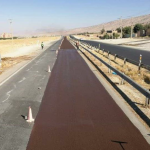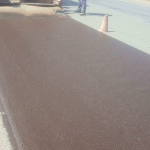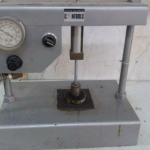Pavements distress as a consequence of a combination of several factors. The main mechanisms of pavement distresses are environment and load-related effects. Load-related effects result in the expansion of structural deteriorations like fatigue cracking and rutting. Environmental effects that include parameters like temperature, oxidation and exposure to sunlight result in thermal cracking, block cracking and raveling. If a proper treatment is not applied at the right time, pavement distresses will extend and will damage subsurface layers.
In order to prevent the deterioration and destruction of pavements, relatively some cost-effective operations can be performed before or even at the beginning of damages.
Preservation of the existing pavements will provide users with good serviceability at an acceptable and safe level. Thus, in recent decades, preventive maintenance operations and applications of pavement repair methods have attracted the attention of researchers and road operators in maintaining pavement conditions at proper serviceability levels.
Among the various types of pavement surface treatments, microsurfacing is one of the most effective cold asphalt mixtures.
Microsurfacing is a preventive maintenance technology which involves application of a mixture of polymer modified emulsion, dense-graded mineral aggregate, mineral filler, water, and additives at ambient temperature.
Microsurfacing seals small cracks and surface imperfections and waterproofs the surface. It provides correction of minor surface profile irregularities, fills ruts and restores surface friction to concrete bridge decks.
Furthermore, microsurfacing is a cost-effective and environment-friendly preservation technique that reduces user delay by allowing traffic in an hour or less after its application. Microsurfacing is vulnerable under the excessive axle loading and is deteriorated over time. However, latex and filler can improve its resistance against the distresses caused by the traffic flow.
In this regard, Raika Rah Gostar Refining and Distribution Company is able to produce bitumen emulsion for microsurfacing using emulsifiers for microsurfacing (AkzoNobel and Cecca).
In this company, we were able to supply bitumen emulsion for microsurfacing in the road construction projects in different regions of the country and neighboring countries, relying on the expertise and experience of several years in this field.
It should be noted that the experienced laboratory staff of Raika Refining and Distribution Company has the ability to perform all the tests required to check the quality and performance of bitumen emulsion for microsurfacing.
Table 1: Standard requirements for aggregate tests of bitumen emulsion for microsurfacing
| Range | Standard | Test | |
| Max. | Min. | ||
| 30 | – | ASTM D131 | Los Angeles Abrasion Value (%) |
| 15 | – | ASTM D88 | Soundness Loss by Sodium Sulfate, (%) |
| – | 65 | ASTM D2419 | Sand Equivalent, (%) |
Table 2: Standard requirements for tests of bitumen emulsion for microsurfacing
| Range | Standard | Test | |
| Max. | Min. | ||
| Tests on Bitumen Emulsion | |||
| 100 | 20 | ASTM D7496 | Viscosity, Saybolt-Furol @ 25°C |
| 1 | – | ASTM D6930 | Storage Stability, 24 h (%) |
| 0.1 | – | ASTM D6933 | Sieve (%) |
| Positive | ASTM D7402 | Particle Charge | |
| – | 62 | INSO 13581 | Residue by Distillation (%) |
| Tests on Residue | |||
| 90 | 40 | INSO 2950 | Penetration @ 25°C, 5 sec (1/10 mm) |
| – | 57 | ASTM D36 | Softening Point (°C) |
| – | 40 | INSO 3866 | Ductility @ 25 °C (cm) |
| – | 97 | ASTM D7553 | Solubility in Trichloroethylene (%) |
| – | 50 | AASHTO T301 | Elastic Recovery (%) |
Table 3: Standard requirements for mix design of microsurfacing mixture
| Range | Standard | Test | ||
| Max. | Min. | |||
| 3 | 2 | ISSA TB106 | Consistency )cm) | |
| – | 120 | ISSA TB113 | Mixing time, (s) | |
| – | 30 | ASTM D3910 | Set time, (min) | |
| – | 90 | ISSA TB114 | Wet stripping (%) | |
| – | 12 | ISSA TB139
ASTM D3910 |
30 min (set) |
Cohesion (Kg-m) |
| – | 20 | 60 min | ||
| 538 | – |
ISSA A105 |
1-hour | Wet track abrasion loss, (g/m2) |
| 807 | – | 6 days | ||
| 538 | – | ISSA TB109 | Sand adhesion by loaded wheel tester (LWT) (g/m2) | |





